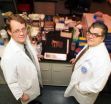"Currently, a disconnect exists between the wealth of scientific advances in research and the incorporation of this information into the clinic," said Susan Desmond-Hellmann, co-chair of the committee that authored the report and chancellor of the University of California, San Francisco. "Often it can take years for biomedical research information to trickle to doctors and patients, and in the meantime wasteful health care expenditures are carried out for treatments that are only effective in specific subgroups. In addition, researchers don't have access to comprehensive and timely information from the clinic. Overall, opportunities are being missed to understand, diagnose, and treat diseases more precisely, and to better inform health care decisions."
"Developing this new network and the associated classification system will require a long-term perspective and parallels the challenges of building Europe's great cathedrals -- one generation will start building them, but they will ultimately be completed by another, with plans changing over time," said committee co-chair Charles Sawyers, a Howard Hughes Medical Institute investigator and the inaugural director of the Human Oncology and Pathogenesis Program at Memorial Sloan-Kettering Cancer Center. "Dramatic advances in biology and technology have enabled rapid, comprehensive, and cost-efficient analysis of patients' health information, which has resulted in an explosion of data that could dramatically alter disease classification. Health care costs have also steadily increased without translating into significantly improved clinical outcomes. These circumstances make it a perfect time to modernize disease classification."
Typically, disease taxonomy refers to the International Classification of Diseases (ICD), a system established more than 100 years ago that is used to track and diagnose disease and determine reimbursement for care. Under ICD, which is in its 10th edition, disease classifications are primarily based on signs and symptoms and seldom incorporate rapidly emerging molecular data, incidental patient characteristics, or socio-environmental influences on disease.
This approach may have been adequate in an era when treatments were largely directed toward symptoms rather than underlying causes, but diagnosis based on traditional signs and symptoms alone carries the risk of missing or misclassifying diseases, the committee said. For instance, symptoms in patients are often nonspecific and rarely identify a disease unambiguously, and numerous diseases, such as cancer and HIV infection, are asymptomatic in the early stages. Moreover, many subgroups of certain diseases have diverse molecular causes and are classified as one disease and, conversely, multiple diseases share a common molecular cause and are not categorized in the same disease classification.
The committee noted several areas where classification of diseases based on genetic makeup is already happening with new drug approvals. For example, in a set of trials on patients with non-small-cell lung cancer, a drug was shown to produce dramatic anti-tumor effects in approximately 10 percent of the patients while other patients did not respond at all. Aided by the dramatic tumor shrinkage, the drug was approved and used on a broad range of lung cancer patients but did nothing for most other than increase costs and side effects. Subsequently, it was discovered that patients who responded to the drug carried specific genetic mutations. This allowed doctors to predict which patients would respond and led to the design of more effective clinical trials, reduced treatment costs, and increased treatment effectiveness. Since then, other studies have further divided lung cancers into subsets that are defined by driver mutations.
Framework to Achieve a New Disease Taxonomy
The committee recommended a modernization and reorientation of the information systems used by researchers and health care providers to attain the new taxonomy and move toward precision medicine. It suggested a framework for creating a "knowledge network of disease" that integrates the rapidly expanding range of information on what causes diseases and allows researchers, health care providers, and the public to share and update this information. The first stage in developing the network would involve creating an "information commons" that links layers of molecular data, medical histories, including information on social and physical environments, and health outcomes to individual patients. The second stage would construct the network and require data mining of the information commons to highlight the data's interconnectedness and integrate it with evolving research. Fundamentally, data would be continuously deposited by the research community and extracted directly from the medical records of participating patients.
To acquire information for the knowledge network, the committee recommended designing strategies to collect and integrate disease-relevant information; implementing pilot studies to assess the feasibility of integrating molecular parameters with medical histories in the ordinary course of care; and gradually eliminating institutional, cultural, and regulatory barriers to widespread sharing of individuals' molecular profiles and health histories while still protecting patients' rights. Much of the initial work necessary to develop the information commons should take the form of observational studies, which would collect molecular and other patient data during treatment. Having this access at point of care could reduce the cost of research, make scientific advances relevant to real-life medicine, and facilitate the use of electronic health records.
The committee noted that moving toward individualized medicine requires that researchers and health care providers have access to very large sets of health and disease-related data linked to individual patients. These data are also critical for developing the information commons, the knowledge network of disease, and ultimately the new taxonomy.
###
The study was sponsored by the National Institutes of Health. The National Academy of Sciences, National Academy of Engineering, Institute of Medicine, and National Research Council make up the National Academies. They are independent, nonprofit institutions that provide science, technology, and health policy advice under an 1863 congressional charter. Panel members, who serve pro bono as volunteers, are chosen by the Academies for each study based on their expertise and experience and must satisfy the Academies' conflict-of-interest standards. The resulting consensus reports undergo external peer review before completion. For more information, visit http://national-academies.org/studycommitteprocess.pdf. A panel roster follows.
Contacts:
Jennifer Walsh, Media Relations Officer
Shaquanna Shields, Media Relations Assistant
Office of News and Public Information
202-334-2138; e-mail news@nas.edu
Pre-publication copies of Toward Precision Medicine: Building a Knowledge Network for Biomedical Research and a New Taxonomy of Disease are available from the National Academies Press; tel. 202-334-3313 or 1-800-624-6242 or on the Internet at http://www.nap.edu. Reporters may obtain a copy from the Office of News and Public Information (contacts listed above).
NATIONAL RESEARCH COUNCIL
Division on Earth and Life Studies
Board on Life Sciences
Committee on the Framework for Developing a New Taxonomy of Disease
Susan Desmond-Hellmann (co-chair)1
Chancellor and Arthur and Toni Rembe Rock Distinguished Professor
University of California
San Francisco
Charles Sawyers (co-chair)1,2
HHMI Investigator
Human Oncology and Pathogenesis Program
Memorial Sloan-Kettering Cancer Center
New York City
David R. Cox1
Senior Vice President and Chief Scientific
Officer
Applied Quantitative Genotherapeutics Unit
Worldwide Research and Development
Pfizer Inc.
San Francisco
Claire M. Fraser-Liggett
Director
Institute for Genome Sciences, and
Professor of Medicine
School of Medicine
University of Maryland
Baltimore
Stephen J. Galli1
Chief of Pathology
Stanford Hospital and Clinics;
Professor of Pathology and Microbiology and Immunology; and
Chair
Department of Pathology
School of Medicine
Stanford University
Stanford, Calif.
David B. Goldstein
Professor of Molecular Genetics and Microbiology, and
Director
Center for Human Genome Variation
Duke University
Durham, N.C.
David J. Hunter
Dean of Academic Affairs, and
Vincent L. Gregory Professor of Cancer Prevention
Departments of Epidemiology and Nutrition
Harvard School of Public Health
Boston
Isaac S. Kohane1
Professor of Pediatrics and Health Sciences
and Technology
Children's Hospital Informatics Program
Harvard Medical School
Boston
Manuel Llinas
Assistant Professor of Molecular Biology
Princeton University
Princeton, N.J.
Bernard Lo1
Director
Program in Medical Ethics, and
Professor of Medicine
University of California
San Francisco
Tom Misteli
Senior Investigator, and
Head
Cell Biology of Genomes Group
Center for Cancer Research
National Cancer Institute
Bethesda, Md.
Sean J. Morrison
HHMI Investigator and Henry Sewall Professor in Medicine;
Professor of Internal Medicine and Cell Developmental Biology
Department of Internal Medicine; and
Director
Center for Stem Cell Biology
University of Michigan
Ann Arbor
David G. Nichols
Vice Dean of Education
Division of Pediatric Anesthesiology and Critical Care
School of Medicine
Johns Hopkins University
Baltimore
Maynard V. Olson2
Professor Emeritus of Medicine and Genome Sciences
University of Washington
Seattle
Charmaine Royal
Associate Research Professor
Institute for Genome Sciences and Policy
Duke University
Durham, N.C.
Keith R. Yamamoto1,2
Executive Vice Dean
School of Medicine, and
Professor
Department of Cellular and Molecular Pharmacology
University of California
San Francisco
RESEARCH COUNCIL STAFF
India Hook-Barnard
Study Director
1 Member, Institute of Medicine
2 Member, National Academy of Sciences
END



